New:
The FOA
2018-19 Update Page covers all the new technology and
applications we covered in this newsletter in 2018-19. Now you
can review all that new tech at once.
The FOA
Fiber FAQs Page (FAQ s = frequently asked questions)
gathers up questions readers have asked us (which first ran
in this newsletter) and adds tech topics of general
interest.
This
months "Good Questions" has some unique
questions from our readers.

Interested
in the infrastructure of smart cities as they deal with the
future of connected and automated vehicles? This comprehensive
educational conference combines presentations, panel discussions
and tutorials, along with visionary keynote speakers, to provide
an end-to-end understanding of the infrastructure requirements
and business opportunities in V2X systems. The meeting is run by
SmartGig Media who ran the excellent SmartGig Cities conferences
a couple of years ago. FOA plans to attend because this is one
big aspect of the evolution of metro communications and relates
to the interest of our new certification partner IMSA, the
traffic engineers.
Learn more
POE,
Digital Electricity, Or Magic?
"Sufficiently
advanced technology is indistinguishable from magic."
Arthur C. Clarke
"Profiles of The Future", 1961
That's straight off slide 2 of a talk I gave recently to
some engineers who were mostly new to fiber optics. I've
used that slide for decades when speaking to groups who were new
to fiber optics because our technology is, well, a bit like
magic/ Sending terabits of data per second down hair-thin
strands of glass with pulses of invisible light seems like it
belongs in some SiFi/fantasy book, right? So I start with that
slide and explain that what we do often seems like magic, but is
real.
Well, an invite for a webinar caught our eye and made us wonder
- was the topic real, Silicon Valley Hype or simply magic.
Digital
Electricity
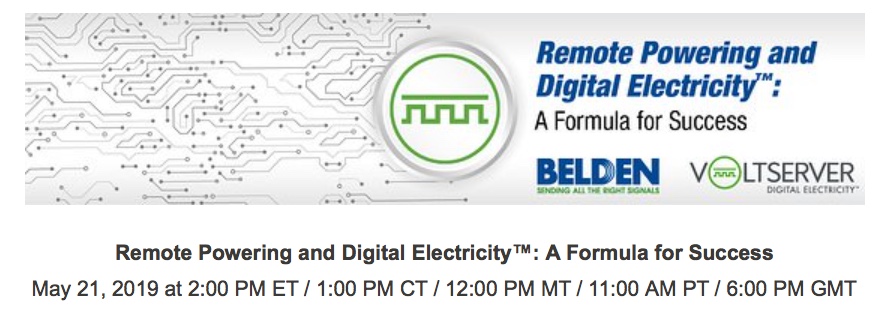
Digital
Electricity™ is the first technology that offers the ability to
safely distribute high-voltage power over long distances. This
opens up new doors for power and data distribution across
buildings, campuses and cities.
Belden and VoltServer have partnered to bring you everything you
need to implement a Digital Electricity solution, from the
components – like transmitters and receivers – to the cabling
infrastructure required to support them.
During this free webinar, you’ll learn more about how Digital
Electricity works, what makes it different from Power
over Ethernet and how it’s set to transform remote
powering. You’ll also learn about the components that make up a
Digital Electricity system, where it can be used and what it
takes to bring Digital Electricity to life. Want to hear about
real-life situations where Digital Electricity is being used in
applications like stadiums and smart buildings to support 5G and
WiFi service? We’ll talk about those, too.
Comments:
Now we know Belden is a very reputable company so they would not
be expected to be promoting something that was not real. But we
spent a long time trying to figure out what "Digital
Electricity" is. We found nothing
useful about what they are doing on Voltserver's
website. Lots of hype and sales stuff. A year-old article
from electronics magazine EDN
by Bill Schweber found them just as confused: "May
17, 2018, I studied their web sites and collateral carefully and
did some other research, and still don’t really grasp how this
set-up works or how it manages to accomplish what seems to be
contradictory and almost unsupportable goals."
A couple of forums populated with electronics nerds gave more
insight, including a couple who had seem products and studied
their patents. It seems they are doing just the opposite of PoE.
PoE uses low voltage which is less dangerous but requires higher
power (electrical power equals volts time amps (V X A) so lower
voltage requires higher amps. More amps means higher power and
losses caused by the resistance which limits the usefulness of
smaller conductors like Cat 5. (See the note below.) Voltserver
goes the opposite way, using high voltage - around 330 volts -
but has sensing circuits that senses any problems on the line
and shuts it down before it can cause damage - or harm to a user
- 330V is high voltage! And they are claiming up to 1kW power
but over unknown cable. And since they claim to send digital
signals over those same wires, how high a modulation rate can
you achieve with 330V digital pulses?
So these people may have something here. If it is viable in the
marketplace is another question.

From
Cabling Installation & Maintenance Magazine, May Issue,
Page 4.
Patrick McLaughlin's magazine covers the premises cabling
business well. This month you can read about PoE standards in an
article on page 4 and the need for certifying cabling for PoE.
What struck us most was this table and how it shows the
efficiency of PoE, shown by the output power of Power Sourcing
equipment (PSE in the drawing above) compared to the PD (powered
device). Note how inefficient PoE is at higher power levels,
even with 4-pair powering. Class 4, Type 3 sources 30W for a max
PD of 25.5W or 85%. Type 4 is 79% efficient. That's a lot of
wasted energy for something that sells on efficiency.
The "digital electricity" uses voltage about 7 times higher, but
appears to claim more than 10 times the power. Tech or magic?
We've analyzed the PoE power efficiency issue in the FOA
Guide page of PoE here. If we can find more out about this
"digital electricity," we'll try to analyze that too.
More
Than A UTP Cable Tester
While were
discussing copper cabling, Softing has introduced the NetXpert
XG cable tester that is also a network tester. It can test Cat
5e and Cat 6 to see if it can support the new speeds for
wireless access points, do BERT tests, TDR testing and more. Read
more.
What's
That Fiber?
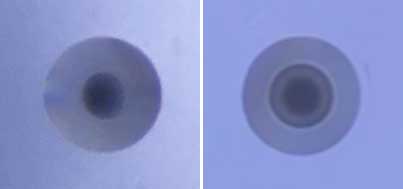
A reader sent FOA these microscope photos of two MM (multimode)
fibers, asking what was the difference with the one on the
right. It is a bend-insensitive fiber and compared to the
regular graded-index MM fiber you readily notice the index
"trench" around the core that reflects light lost in stress
bends right back into the core. You can read
more about bend-insensitive fiber in the FOA Guide.
Dealing
With High Fiber Count Cables - Share Your Experiences!
We ran
this first in the March 2019 FOA Newsletter and asked for
feedback. We have some feedback and have been talking to
people in the industry also. We thought we'd share some of
what we've been told and see if others agree. Feel free to
comment!
UPDATE-
April 2019:
High Fiber Count Cables may not be for everyone. Maybe only for
a very few. A single cable that has as many fibers as 12-144
fiber cables (1728 fibers) in a cable with a diameter of only
twice that of a conventional 144 fiber cable can present
challenges.
- First
of all, the cost - it's high. You do not want to waste cable
at this price. Engineering the cable length precisely will
save lots of money.And it's worse for higher fiber counts.
- Likewise,
making mistakes when preparing the cable for termination can
be expensive.
- The
cable may require special preparation procedures to separate
fibers for termination. Most use new methods of identifying
cables and bundles.
- Besides
skill, the tech working with high fiber count cables needs
lots of patience.
- Splicing
multiple cables at a joint can get complicated keeping all
fibers straight.
- These
cables will generally use 200 micron buffered fiber and
often a flexible ribbon instead of a typical rigid ribbon
structure to reduce fiber sizes. This may complicate
splicing as the methodology to splice the flexible fibers
and splice 200 micron fibers to regular 250 micron fibers is
a work in progress.
- Splicing
200 to 250 micron fibers may be easier with the flexible
ribbon designs which make it easier to spread fibers to the
same spacing.
- We've
heard the splicing time for flexible ribbons is about twice
that of conventional rigid ribbons. So if you use that table
below, you may need to double your ribbon splicing estimates
when working with flexible ribbons.
Agree?
Disagree? Comment?
ORIGINAL Article: March 2019
FOA has recently gotten several inquires about these new high
fiber count cables - 1728, 3456 or even 6,912 fibers. Like
this one from Prysmian with 1728 fibers:
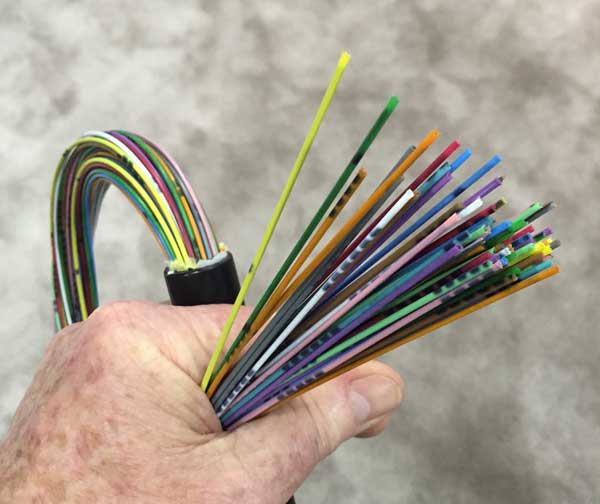
We've been looking for directions on how to deal with high fiber
count cables. Several contractors tell us ribbon splicing is the
way to go, and most of these cables now use a version of the new
ribbon types that are flexible. We've put together this
table from some articles on splicing ribbons:
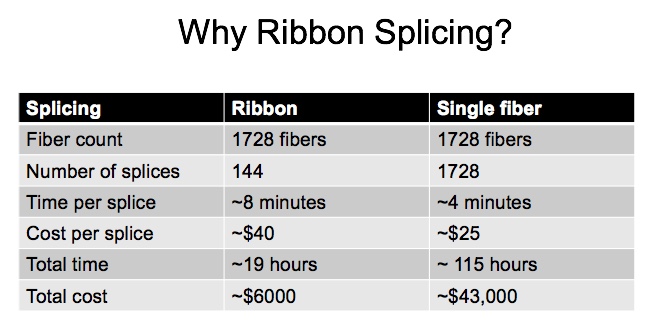
Is that realistic? We've heard the flexible ribbons may take
twice as long as the conventional ribbons.
Here's links to some of the information we've been reading
and watching online:
Corning
sticks with solid ribbons in high density cables.
Corning
ribbon splice closure for 1728 fibers.
Directions from Corning
on ultra high-density cabinets
Designing
a high fiber count cable with flexible ribbons - SEI.
Fujikura
(Japan) Highest density Optical Fiber Cable.
OFS
Presentation on 200micron buffer, bend insensitive, high fiber
count cables.
Ribbonizing
250 micron loose tube fibers for splicing, AFL Fujikura.
(video). (Written
instructions too.)
Splicing
AFL "SpiderWeb ribbon cable.
Ribbonizing
250 micron loose tube fibers for splicing, Sumitomo.
(video).
Procedures
for ribbonizing and de-ribbonizing fibers. (Telonix).
Some
things you need to know about splicing 200micron buffered
fibers.
Some
things you need to know about the new ribbon cables
(Prysmian)
More
coming next month!
We'd
like more information for a future story on these
cables, new ribbon types and how installers deal with them.
Share
your experiences - email us at jim @foa.org.

FOA
Guide Adds And Updates More Pages
On
Jargon, Restoration, Fiber Characterization And Management
The FOA
Guide is a living thing, growing bigger and better
continuously, updated for new technology and techniques, aimed
at keeping the world up to date on fiber optics and cabling. In
the last month alone, the Guide has added three new sections you
should find interesting, informative and helpful and updated a
couple more.
Fiber
Optic Jargon - Illustrated
FOA has
always believed that jargon is important - it's the language we
use - and fiber optics has a lot of its own language. As you
have probably noticed, Chapter 2 in all our textbooks is
"Jargon." That chapter gives an introduction to the language and
helps get the reader familiar with the terminology before they
delve into the rest of the book. This month, we updated all the
jargon pages to include dozens more photos and drawings -
animations too - that make it even easier to understand fiber
optic jargon. Take a look at Basic
Fiber Optic Jargon, OSP
Fiber
Optic Jargon and Fiber
Optic Jargon for managers.
Fiber
Optic Restoration
All
networks are susceptible to problems that affect
communications. A consequence of fiber optic systems’ high
bandwidth, long distance capability and security is the
extreme dependence of users on the non-stop operation of
these systems. They can transmit large amounts of data long
distances with immunity from signal degradation and
extremely high reliability, so these systems usually carry
the most critical data. If something happens, it’s important
to not panic. You should have a plan, components set aside
for repair and knowledgeable people on stall or a contractor
on call. When you design the network, restoration planning
should be part of the design. If you did not do that, now is
the time to do it before something happens. FOA
has a new page on Restoration in the FOA Guide that
provides advice for everyone - contractors/installers,
network owners and managers - everybody who gets involved
when the network goes down.
Fiber
Characterization
As networks
get faster and link spans get longer, fiber characterization
becomes more important to he network owner and
contractor/installer. Chromatic dispersion, the dispersion
caused by light of different wavelengths, and polarization mode
dispersion, caused by the polarization of the light in the
fiber, become factors limiting the bandwidth capacity of fiber
links. Pulse broadening due to dispersion and the variation of
fiber attenuation with wavelength can become issues with DWDM.
All these factors need testing on long distance networks to
ensure proper link performance. Tests are performed on new
installations to ensure the fiber being installed is capable of
future upgrades. Older cable plants are tested to evaluate
fibers for upgrades of legacy communications systems at slower
speeds. We've created a certification program for fiber
characterization, CFOS/FC, but not many FOA schools have the
equipment to teach the course. In addition, we've had requests
for a course for managers, not technicians, who don't need to
know how to perform all the tests but do need to know what the
problems are, what fiber links need testing and how to find
competent contractors to do the work. The updated Fiber
Characterization page in the FOA Guide goes in to more
depth on why fiber
characterization is important, what tests need performing and
how to interpret results.
Fiber
Optic Testing
Practically
every page in the section of the FOA Guide on Fiber Optic
Testing has been reviewed and updated, much of it based on the
new FOA textbook on testing. This includes pages on measuring
power, fiber attenuation, connector or splice loss and cable
plant loss. Browse
through the testing section and see what's new.
Fiber
Optics For Managers
In
the FOA, as part of the fiber optic industry and especially in
our role as educators, most of our focus has been training the
designers and installers of fiber optic cable plants and
networks. But what about the people for whom they work or
build the networks? What do network managers, project
managers, supervisors,
network owners, IT personnel, facilities managers, network
designers, estimators, inspectors, etc. need to know about
fiber optics to ensure the success of their project?
FOA
has been working with several groups to develop educational
programs for managers. We've started with a page in the FOA
Guide on Fiber
Optic Network Management that describes what our advisors
think is important and created a page to introduce them to the
language and technology of fiber optics which we call "Fiber
Optic Jargon - Illustrated." Over time, we'll be expanding
this section and create a Fiber U self-study course also.
The
FOA Guide to OSP Construction
FOA has
created a new section of the FOA
Guide on OSP
Construction. We've expanded some sections to
include more on cable pulling, blowing and aerial construction
with lashed and ADSS cables. The FOA has extensive material
available in our textbooks and online FOA Guide on what is
involved in the fiber installation process (cable installation,
preparation, splicing, termination and testing), so consider
this the textbook for the construction processes that occur
before the typical FOA CFOT-certified techs begin their work.
Included in this new Guide is comprehensive information on new
techniques like air-blown cables using microcables and
microducts. It also covers aerial cable installation more
thoroughly than is typically found in websites or literature.
The audience for this new section of the FOA Guide includes the
management of organizations owning or installing fiber optic
cable plants, designers or estimators of the cable plant, as
well as the actual CFOT certified techs doing the installation
work. It is intended to provide background information on the
entire project and in conjunction with the other FOA information
on basic fiber, OSP fiber, design and testing, provide complete
information on all stages of a fiber optic communications
project.
The
FOA Guide to OSP Construction
FOA
Guide on Inspecting and Cleaning Connectors.
Dirty
connectors are one of the major problems in fiber optics,
causing high connector loss, high reflectance and
contaminating transceivers. Network operators claim that
15-50% of all network problems can be traced to dirty
connectors causing connection problems.
FOA
Guide section on inspecting and cleaning connectors.
Test
Equipment And Inspection Microscopes for MPO Connectors

The fiber
optic industry has seen a number of recent introductions of
inspection microscopes and test equipment for the MPO multifiber
connector. It's about time, many people think, since the
connector has been around for over a decade and has always been
a problem to inspect and test. Earlier inspection microscopes
with MPO adapters required manipulating the adapter to see
individual fibers, but the new ones view more fibers and/or
scan. EXFO's solution includes a source and can also do polarity
checking, a nice feature. The test sets from Viavi and Fluke are
multichannel OLTS, finally making MPO testing a reasonable
exercise. Several vendors sell switches for OTDR testing also.
We saw several others from unknown manufacturers we did not
include. If you have suggestions for additional equipment,
contact <jim@ foa.org>.
Here's a rundown of what we found:
AFL FOCIS
Lightning Multi-Fiber Connector Inspection System
https://www.aflglobal.com/Products/Test-and-Inspection/Fiber-Optic-Inspection/FOCIS-Lightning-Multi-Fiber-Connector-Inspection-S.aspx
AFL
Multifiber Switch
https://www.aflhyperscale.com/product/multi-fiber-switch
AFL
Multifiber Tracer (VFL)
https://www.aflhyperscale.com/product/mt-tracer-12-fiber-vfi-and-display
EXFO
ConnectorMax MPO Link Test Solution - polarity, continuity and
connector testing
https://www.exfo.com/en/products/field-network-testing/fiber-inspection/connectormax-mpo-link-test-solution/
EXFO
TK-Switch MPO and MTP Kit (12 fiber switch for SM MPOs with
OTDR)
https://www.exfo.com/umbraco/surface/file/download/?ni=11018&cn=en-US&pi=8939
Fluke
FI-3000 FiberInspector™ Pro MPO Inspection Camera
https://www.flukenetworks.com/datacom-cabling/Versiv/fi-3000-fiberinspector-pro-mpo-inspection-camera
Fluke
MultiFiber™ Pro Optical Power Meter and Fiber Test Kits
https://www.flukenetworks.com/datacom-cabling/fiber-testing/multifiber-pro-optical-power-meter-and-fiber-testing-kits
Kingfisher
- Several microscopes and test kits
https://www.kingfisherfiber.com/for/mpo-mtp-and-ribbon-fiber/fiber-test-kits
Viavi
FiberChek Sidewinder
https://www.viavisolutions.com/en-us/products/fiberchek-sidewinder
VIAVI
SmartClass Fiber MPOLx - MPO Optical Loss Test Sets
https://www.viavisolutions.com/en-us/products/smartclass-fiber-mpolx-mpo-optical-loss-test-sets
Summix
Microscope Probes and Interferomenters For MPOs
http://sumix.com
If
you have suggestions for additional equipment for this list,
contact <jim@ foa.org>.
FOA
School Offers Toolkit With Online Training

Slayton
Solutions (FOA Approved School #156) is offering a simple
fiber optic tool kit that includes a 29-piece set of fiber
optic tools and a power meter along with training videos and
online instruction for only $499. 29 Piece Kit includes all
tools and devices a technician needs to install fiber optic
connectors and test optical power. Information
on the kit is available on YouTube.
You can contact them for more information at
slaytonsolutions@sbcglobal.net
or https://www.fiberopticsinstitute.com
Troubleshooting
With A VFL: Fibers
Damaged In Splice Trays
Is this
a trend? Twice in one week, we have inquiries from readers
with problems and both were traced to fibers cracked when
inserted in splice trays. The photo below shows one of them
illuminated with a VFL. This was the same issue we found in
the first field trial of a VFL more than 30 years ago that led
to its popularity in field troubleshooting.

Photo courtesy
Alan Kojima.
Welcome
To The New FOA Schools in Greece, Jackson, MS And Charlotte,
NC
FOA is
pleased to announce that School
of Telecoms in Aigaleo, Greece (FOA school 768), Fiber
Wizards (FOA
school 380) and OnePath
LLC in Charlotte, NC (FOA school 379) have joined the
FOA as an approved schools offering FOA certification.
Want To Be A Guinea Pig And Save?
As part of our program to adhere to international standards for
certifying bodies and to ensure FOA certified techs are up to
date on the latest technologies and applications, FOA is also
considering adding a short online course based on our annual "Fiber
Update" as a future requirement for renewal. This course
would cover new technology and applications that FOA thinks all
technicians should be familiar with. Over the next year we will
be testing this concept by offering it to selected individuals.
You may be one of those selected! Watch your email for your
renewal notice.
Worth
Reading - News Summary
Cabling
Installation & Maintenance Magazine, May Issue.
Patrick McLaughlin's magazine covers the premises cabling
business well. This month you can read about PoE standards
(Page 4 - note how inefficient it is at high power levels) and
why Cat 8 is a non starter (P15)
Ckearfield-FOA
Certification Training Clearfield
is now offering their customers an FOA
CERTIFICATION course. This
course provides a basic understanding of fiber optic
technology, as well as Clearfield product knowledge and how
Clearfield’s integrated product systems work together in a
fiber network.
Singlemode
Vs. Multimode Fiber: The Real Differences. Kudos
to Jim Zimnicki of Belden who wrote this informative article.
The cheer is because he used a diagram that did not show the
fiber with the core sticking out of the cladding! Let's hope
this is just the beginning of the industry showing fiber the
right way.
Tennessee
Should Let Municipalities Build Fiber Networks To Meet
Demand - If it wasn't for those pesky laws written
by the giant incumbent service providers.
How
In-Cassette Splicing Reduces Your Cost. (Clearfield)
By
having fewer product components and using products that
combine functions, you’ll find the overall network costs drop
due to less complexity while keeping flexibility.
Guidelines
for leasing dark fiber - Murphreesboro, TN. (With prices!)
The
true cost of telco damages (e.g. dig-ups) (with checklist)
Watay
Power Far north First Nation system - (from Bill
graham)
This Canadian project will bring electricity to 24 first Nation
reserves including the farthest ones north, Bearskin Lake and
Sachigo Lake. The towers will have OPGW and
ADSS for SCADA and other communications. all cables will
contain 96 fiber.
The
Joy of Standards - NYTimes - Life
is a lot easier when you can plug into any socket.
Colorado
DOT Installing Fiber Along Roadway Near Colorado Springs
-(KKTV) - 17 miles buried along roadway for $2.5m - that's
$147,058/mile - ~$28/foot or ~$91.40/meter.
What's
Going On At Bell Labs: IP and Optical Networks.
We can approach the theoretical maximum information
transfer rates, as defined as the Shannon Limit,
discovered in 1948 by Claude Shannon, Bell Labs pioneer
and “father of information theory”.
5
Best Practices for Utilizing GIS Data.
(White paper) American City
& County
Substandard
Contractors - Fiber Optic Knowledge Doesn't Always Trickle
Down (EC Mag)
Yokogawa
Releases OTDR for Rapid Testing of PON Access Networks

AMERSFOORT, THE NETHERLANDS — The new Yokogawa AQ1210 OTDR
(optical-time domain reflectometer) only resembles the existing
AQ1200 in appearance - internally it has been completely
re-engineered to bring the features and user-friendly operation
of the AQ7280 flagship OTDR to the installers and testers of
passive optical networks (PON) and fibre to the antenna (FTTA).
PON is typically used throughout the world to provide optical
fiber-based services to domestic and commercial customers. With
6 models offering 2 or 3 wavelengths, and the ability to test
live fibre networks with high-port count splitters (up to
1:128), every user can find an AQ1210 model with the combination
of wavelengths required to meet the testing needs of their local
country or region.
For further information on the AQ1210 OTDR visit: https://tmi.yokogawa.com/eu/solutions/products/optical-measuring-instruments/optical-time-domain-reflectometer/aq1210-series-optical-time-domain-reflectometer/
Resource
For Small, Private FTTH Systems
Phil
Trubey worked with his homeowners association to research and
develop a FTTH network. In doing this, he researched FTTH
thoroughly (including FOA). He's created a website to share
what he learned. FTTH.Build
is an informational site for HOAs and small communities
on how to build your own Fiber To The Home gigabit Internet
network.
This web site is to help Home Owners Associations and other
small communities who are looking to build their own fiber
optic network to provision gigabit Internet for their
residents. It assumes that you are on your own, and no telecom
carrier is interested is building out a fiber network for your
area. Methods described here are applicable to communities
ranging in size from a couple of hundred residents to 20,000
or more residents.
Visit http://ftth.build
Updated
FOA Certifications
We continue
to expand our certification offerings, adding "Fiber For
Wireless" last year, and fine-tuning our current
offerings to keep up with the changes in fiber optic technology
and applications. In the last year we've updated our CFOT, CPCT
and CFOS/O certification programs and their FOA references
online and in textbooks.
The CFOT fiber certification update includes adding more
information about new technology and products like SOCs
(splice-on connectors), microcables, as well as expanding the
information on OSP and premises applications. The CPCT premises
cable program has been updated to cover the new technology in
areas like passive OLANs and data centers.
The biggest change in FOA programs was to the CFOS/O Outside
Plant (OSP) Specialist program. We were asked to cover more
about OSP construction so we integrated the material from the
FOA OSP Construction Guide written by FOA Master Instructor Joe
Botha into the course. To make room for the new material, we
changed the prerequisites of the course to require a CFOT,
instead of covering basic fiber tech in the OSP course.
FOA
Certifications Now Last For 3-Years
Beginning
in 2019, all FOA certifications issued or renewed will be for a
period of 3 years. Most certification bodies worldwide have
standardized on 3 year certifications. FOA has been working with
a number of organizations that use our programs but have
standardized on 3 year certifications. FOA has decided that it
is time to change our policies to align with the majority of
other organizations.
Remember that FOA certification renewals include all the
certifications one individual has for one price. FOA does not
charge for any additional certifications, so, for example, if a
CFOT also has specialist certifications like the CFOS/T or
CFOS/S, they are included at no additional cost when the basic
certification is renewed.
Now that we
have the FOA Guide on OSP Construction, we can do a free Fiber U
online course on the subject. The new Fiber
U Course On OSP Construction includes a
review of fiber optic technology for those just getting started
or looking for an update, a lesson on project preparation, then
covers underground construction, underground cable installation,
aerial cable construction and installation, then leads you to
the next steps in OSP construction, splicing, termination and
testing.
This Fiber U course is aimed at managers of fiber optic
projects, either with the network owner or the contractor
building it, want to know how this construction is done and how
it needs to be designed, estimated and construction. It is also
appropriate for installers and contractors who are involved in
the construction process also.
Take the free Fiber
U Course On OSP Construction here.
As we researched products and installation practices for
the new OSP Construction sections, we came across some
interesting products and services. See
OSP
Construction below.
New
FiberNext Job Board And Savings Club For CFOTs

FOA
Approved School FiberNext
has created an online job board for fiber techs and a special
"savings club" for CFOTs.
Job
Board
The
Job Board was designed to help connect employers with fiber
technicians and other fiber optic professionals. It is a place
where employers in the fiber optic market can post job
openings and a place where fiber optic professionals can post
that they are looking for employment. Please feel free to post
an opening or browse for your next job or employee. https://fibernext.com/job_board.php
Savings Club
FiberNext, besides being an FOA approved school is also a
distributor. FiberNext invites FOA CFOT®s to join the “FiberNext
CFOT® Club to get special savings on selected fiber optic
products. Visit https://fibernext.com/cfot_club.php to
sign up today ”
Recycling
Fiber Optic Cable
We
received this note from Steve Maginnis, LD4Recycle/ CommuniCom
Recycling on recycling fiber optic cable:
We have 3 Processors gearing up to accept fiber optic
cable (FOC). As we all know, all FOC is not the same. Several
truckloads of “typical” FOC scrap from FOC mfgrs and “typical”
FOC and Coax cable have been studied and tested.
Therefore, today you can begin contacting me with the type FOC
material or scrap you toss to the landfills today. We need to
quantify the expected feedstock. Our expectation for quantities
is quite large (tons) but there is a capacity limit. And I do
have several processors that can take ALL materials and others
that can accept LIMITED types of FOC material and quantity.
Contact:
Steve Maginnis
LD4Recycle/ CommuniCom Recycling
(Visit our new
website)
sm@LD4Recycle.com
803.371.5436
Safety
On The Job
Safety is
the most important part of any job. Installers need to
understand the safety issues to be safe. An excellent guide to
analyzing job hazards is from OSHA, the US Occupational Safety
and Health Administration. Here
is a link to their guide for job hazard analysis.
Investigators
Eye Fiber Optic Work in Deadly Wisconsin Gas Explosion
Firefighter
killed, nine injured, and three buildings destroyed in
downtown Sun Prairie, Wis.
A hole punched into a 4-in.-dia gas pipeline during
fiber-optic line laying is blamed for an explosion that killed a
34-year-old fire captain and injured nine other people,
including four firefighters, in downtown Sun Prairie, Wis., on
July 10. The injured were treated at nearby hospitals and have
since been released. The blast destroyed three buildings,
including the Barr House, a tavern at 100 Main St. that was
owned by the deceased fire captain, Cory Barr.
Sun Prairie Fire Chief Chris Garrison said at a news conference
that after the leak was initially reported at 6:20 PM CDT, first
responders established a 300-ft-dia "hot zone" in the area and
evacuated about 65 people before the explosion occurred. "The
rapid response of firefighters, EMS and police saved a lot of
lives," Garrison said. "This could have been a lot more tragic
than it was."
The owner of the fiber-optics network is Verizon Wireless, which
confirmed in a statement that it had contracted with Bear
Communications "to provide a fiber backhaul for our networks."
It added that no Verizon employees were present at the job site.
"Verizon does contract with local providers in various markets
to provide fiber backhaul for our networks," the Verizon
statement said. "While we have not been contacted about the
investigation, both we and Bear are prepared to work with law
enforcement, public safety and public officials as they
investigate this tragic situation."
Read
the story in ENR. And the final
report by the NTSB details the mistakes made by the
contractor.
FOA also has lots of information on safety: FOA
Guide, YouTube
video and a Safety
Poster
Best
Practices Guide For Underground Construction
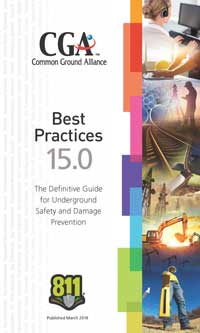
We assume
you are familiar with the "One Call" and "Call Before You Dig"
(811) program, but are you also familiar with the people behind
it - the Common Ground Alliance and their Best Practices
website?
CGA
is a member-driven association of 1,700 individuals,
organizations and sponsors in every facet of the underground
utility industry. Established in 2000, CGA is committed to
saving lives and preventing damage to underground
infrastructure by promoting effective damage prevention
practices. CGA has established itself as the leading
organization in an effort to reduce damages to underground
facilities in North America through shared responsibility
among all stakeholders.
Officially
formed in 2000, the CGA represents a continuation of the
damage prevention efforts embodied by the Common
Ground Study.
Sponsored by the U.S. Department of Transportation and
completed in 1999, this Study represents the collaborative
work of 160 industry professionals who identified best
practices relating to damage prevention. Any
best practice or program endorsed by the CGA comes with
consensus support from experts representing the following
stakeholder groups: Excavators, Locators, Road Builders,
Electric, Telecommunications, Oil, Gas Distribution, Gas
Transmission, Railroad, One Call, Public Works, Equipment
Manufacturing, State Regulators, Insurance, Emergency
Services and Engineering/Design.
Read
the CGA Best Practices Guide here.
Here
are all the CGA resources for damage prevention.
FOA
Facts
FOA is a
non-profit professional society whose members are all certified
techs - mostly CFOT®s
-Certified Fiber Optic Technicians - but also may be CPCTs -
Certified Premises Cabling Technicians or corporate
members involved in fiber optics.
FOA is a "virtual organization" - we have no "brick and mortar"
presence. We operate over the Internet with operations centered
in California, with active workers and volunteers in locations
as diverse as Texas, Ohio, Canada, Singapore, Malaysia, Denmark,
South Africa, the Middle East and many more.
Being a virtual organization, FOA has very low overhead,
allowing us to offer cost-effective certifications and many free
programs to support our industry.
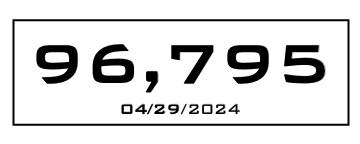
As of today, FOA has certified this many techs. About 90% come
from our schools but many experienced techs have become FOA
CFOT-certified directly through our "Work-to-Cert"
program.
FOA has almost 200 approved training organizations in about 40
countries around the world around the world.

FOA has 14
fiber optic certification programs covering every aspect
of fiber optic network design, installation and operation.
Primary
Certifications: CFOT (basic fiber), CPCT (premises cabling),
CFOS/O (outside plant, taught with CFOT included) and CFOS/D
(fiber optic network design).
Skills Certifications (for installers and techs, requires
CFOT): CFOS/S (splicing), CFOS/C (connectors/termination),
CFOS/T (testing), CFOS/FC (fiber characterization).
Applications Certifications (for techs or anyone, including
managers and supervisors): FTTH (fiber to the home), CFOS/L
(optical LANs), CFOS/DC (data centers), CFOS/A (fiber to the
antenna), CFOS/DAS (distributed antenna systems) and CFOS/W
(fiber for wireless)
 (what you are reading)
(what you are reading)
FOA monitors the trade press, websites and other
resources continually to look at what's happening in many
technologies that affect fiber optics. We're tracing
technologies as diverse as wireless, IoT, autonomous vehicles,
smart cities, energy, or anywhere fiber is used to bring news to
our readers.
FOA continually updates our technical materials, online and
printed, and our curriculum to ensure our readers have access to
the latest technical information and our schools teach the
latest technology and applications. Our printed books are being
updated right now.

FOA created the
FOA Online Guide as a non-commercial trustworthy technical
reference almost a decade ago so the industry would have a
reliable technical reference. In the last year, over 1million
visitors downloaded about 4 million pages of technical
information.
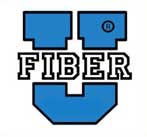
FOA offers free online self-study programs at Fiber
U. In 2017, the number of online sessions doubled to
200,000. Many of those are preparing for FOA certification
programs - taking courses at our schools or using the "Work-to-Cert"
program. Some of our schools are requiring Fiber U programs as
prerequisites for their classroom courses so they can spend more
time on hands-on activities.

FOA offers over 100 educational YouTube
videos that have been viewed 2.4 million times.
FOA offers its training programs to other organizations at no
cost to help them train their members properly in fiber optics.
For example, FOA has been working with the Electrical Training
Alliance (IBEW/NECA) for over 20 years, training their
instructors for their apprenticeship programs. We work with many
other organizations and companies to provide the materials they
need.
FOA has about 300 corporate
members - companies in various aspects of the fiber optic
industry worldwide that we list online and offer discounts on
certifications and renewals.
FOA provides speakers for many conferences and even
presentations for use by other organizations to educate people
on the aspects of fiber optic communications.
FOA has a program to provide classroom
materials for STEM
teachers (science, technology, engineering and math)
introducing K-12 students to fiber optics and creating science
projects.
FOA provides forums for discussion on various social media. Our
LinkedIn groups have about 5,000 members each. If you are not
joining us on social media yet, please do.





New
From FOA
Interested
In A Career In Fiber Optics?

FOA has created a new YouTube video to introduce students to
careers in fiber optics. It was made for showing to high school
and junior high students interested in tech careers but anyone
interested in a possible career in this field will find it
interesting. If you have kids in school or know teachers, let
them know about this too. Watch the FOA
Careers In Fiber Optics Video on YouTube and visit the FOA
Careers In Fiber Optics web page at www.foa.org/careers/.

The word on
the "Dig Once" program is getting out - FOA is getting calls
from cities asking us for information and advice. It helps that
the current Administration is trying to convince cities of the
advantages of installing ducts or conduits when they dig up a
street so they don't have to do it again. Here are some links
for more information.
The DoT page on the administration’s Executive Order: http://www.fhwa.dot.gov/policy/otps/exeorder.cfm
From the Council of State governments: http://www.csg.org/pubs/capitolideas/enews/cs41_1.aspx
From the city of San Francisco: http://sfgov.org/dt/dig-once
An article about Dakota County, MN: https://muninetworks.org/tags/tags/dig-once
And
the one to download and hand out:
A “How To” Guide from The Global Connect Initiative: https://share.america.gov/wp-content/uploads/2016/04/6.-GCI-Dig-Once.pdf
Useful
Online Resources
We often
have contacts give us online links for useful information which
we like to share with our readers. Here are two:
Why
We Warn You To Be Careful About Fiber Shards
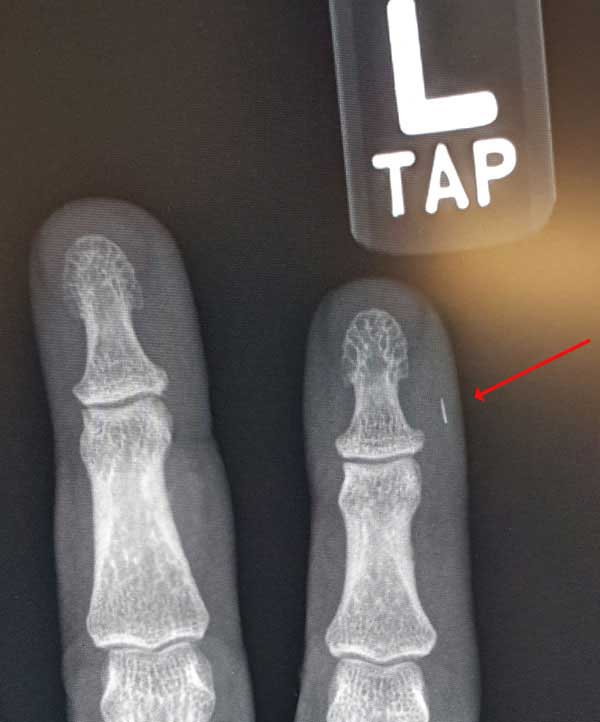
Photo courtesy Brian Brandstetter, Mississauga
Training Consultants
1-844-440-0047
www.fiberoptictraining.com
Another
Source Of Articles On Fiber
FOA
President and editor of this newsletter Jim Hayes has also been
writing a column in Electrical
Contractor Magazine for more than 15 years now. Electrical
contractors do lots of fiber work and this column has covered
some toics they are interested in including installation
processes, network design, fiber applications and in the last
year, a lengthy series on dark fiber - what it is, how's its
used and how it benefits the growth of communication. A recent
web site redesign makes it easier to browse all these articles -
just go to http://www.ecmag.com/contributing-authors/jim-hayes
and you can see all of them.
Fiber
Optic Education For Students At Any Age
We hear
about fiber optics all the time - it's in the news whenever we
hear articles about high tech, the Internet and communications,
and many communities are getting "fiber to the home." But few
people really understand fiber optics or how it works. FOA is
focused on educating the workforce that installs and operates
these fiber optic networks but we're always getting inquiries
from STEM (science, technology, engineering and math) teachers
who want to introduce fiber optics to younger students in K-12
grades or technical schools.
We
start with the FOA
Careers In Fiber Optics Video on YouTube and visit the FOA
Careers In Fiber Optics web page at www.foa.org/careers/.
These are for students who think they might be interested in
careers in fiber optics and want to know more about what fiber
techs do.
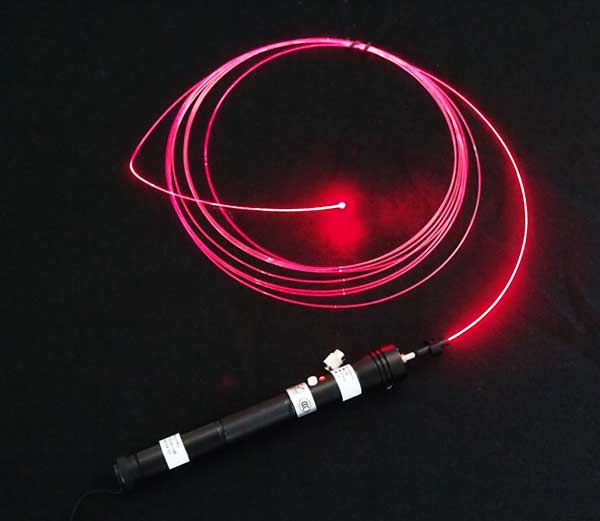
Using red laser light (a VFL here but a laser pointer works
also) to show how fiber guides light.
FOA has begun developing a series of YouTube videos intended for
teaching students in elementary, middle and high schools about
fiber optics. The first FOA video is titled "Fiber
Optics For Teachers." With this video, we show teachers
how fiber works and carries signals and then explains simple
experiments to demonstrate how fiber optics works in the
classroom using some plastic fiber and a laser pointer. Since
many teachers do not know where to get the fiber, the FOA offers
to send them a sample for use in demonstrations in their
classroom (USA only right now.)
At the end of the video, teachers are given directions on how to
request samples of the plastic fiber from the FOA.
This video joins the "Fiber Optics Live" series How
Light Travels In A Fiber, Fiber
Attenuation and Connector
Loss that show how fiber works using simple experiments
that can be duplicated in any classroom. More videos will be
coming soon.
If you have kids or know some teachers who would be interested,
please send them to the introductory video Fiber
Optics For Teachers and we'll be glad to help them
get started with some entertaining programs for their
classrooms.
Resources
For Teachers In K-12 And Technical Schools
Teachers in all grades can introduce their students to fiber
optic technology with some simple demonstrations. FOA has
created a page for STEM or STEAM (science, technology,
engineering, arts
and math) teachers with materials appropriate to their
classes. Fiber Optic
Resources For Teachers.
If
you have kids in school or know teachers who are interested,
send them to the FOA page Fiber
Optic Resources For Teachers.
Should
Your Company Become An FOA Corporate Member?
As all FOA
individual
members know, they join the FOA by becoming certified,
mostly taking their CFOTs but some CPCTs, either by
attending a FOA approved school or joining directly based on
field experience (our "work to cert" program.) Over the years,
we've been contacted by manufacturers, contractors, consultants,
and other types of organizations who ask about becoming members.
We don't certify companies or organizations, we told them, so we
were not sure what we could offer as a benefit of membership.
But then, companies asked about using our educational programs
to train employees, how they could get listed on the FOA website
as service providers or if they could get a quantity discount on
membership or certification for all the FOA members working for
them. That began to sound like a benefit for being an FOA
corporate member. And providing a list of useful suppliers to
the market could be a benefit to the industry as a whole.
So FOA has quietly been letting companies and other
organizations join the FOA to take advantage of those benefits
so we now have several hundred corporate members. We've put then
into a database and listed them on the FOA website in map
and list
form. Here's the map.
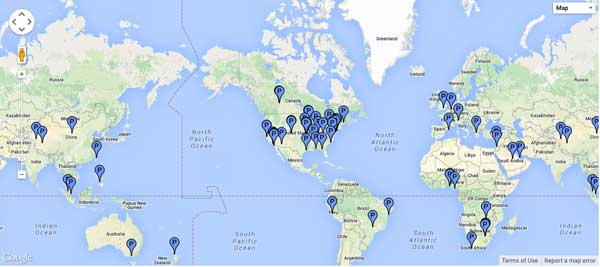
The online map
and list
can be used to find suppliers and service providers.
The map, like our map of schools, lets you find the FOA
corporate members close to you. The table form lists them
by category: Installer/Contractor, Component Manufacturer,
Installation Equip. Manufacturer, Transmission Equipment,
Services/Consulting, Distribution and Users of Fiber Optic
Networks. You can sort the tables to find members meeting your
needs, e.g. by location, certifications offered, etc. Click on
any column heading to sort that column; click twice to sort in
reverse order.
How
Does An Organization Become An FOA Corporate Member?
Simple,
just fill in the online
application form. When your application is accepted, you
will be asked to pay the one time membership fee - $100US. You
will then be listed on the online
map
and list,
have access to exclusive FOA educational materials for your
employees and get discounts on certifications and
renewals.
Events of
Interest: FOA
now posts events on our LinkedIn groups, Facebook page and
other social media

FOA
has a company page and three LinkedIn Groups
FOA
- official company page on LinkedIn
FOA
- covers FOA, technology and jobs in the fiber optic marketplace
FOA
Fiber Optic Training - open to all, covers fiber optic
technology and training topics
Grupo
de La Asociación de Fibra Óptica FOA (Español)
RETURN
TO INDEX
 FOA Resources
FOA Resources
FOA
Standards:
FOA offers free standards for datalinks and testing the
installed fiber optic cable plant, patchcords and cable, optical
power from transmitters or at receivers and OTDR testing. Look
for the "1
PageStandard" web page and in the FOA Online Reference
Guide.
NECA/FOA
301 Fiber Optic Installation Standard
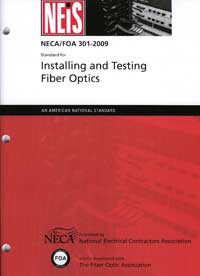
Standards
cover components and systems and how to test them, but rarely
get into installation issues. The FOA NECA 301 standard which
covers installation of optical fiber systems has been revised
for the second time, adding considerable new materials. This
standard is derived from FOA educational material put in
standards form and approved by ANSI as an American National
Standard. It's specifically written to be used in contracts to
define "installation in a neat and workmanlike manner." The
standard is available from NECA.
FOA members can go
here for instructions on how to download your free copy.
RETURN
TO INDEX
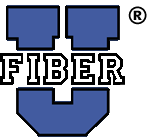
Free
Fiber U Self-Study Programs
FOA's
"Fiber U" free online self-study programs help you learn about
fiber optics, study for FOA certifications or use them to help
create "blended learning" classes. There are two new free online
self-study programs on Fiber
U. Fiber Optic Network Design is for those interested in
learning more about how to design fiber optic networks or
studying for the CFOS/D certification. FTTx is for those wanting
to know more about fiber to the "x" - curb, home, wireless, etc.
- or studying for the CFOS/H certification.
Got to Fiber U
for more information.
Fiber U
Online Self-Study Programs Offer Certificates of Completion
FOA has
been offering quite a few free online self-study programs on Fiber
U, our online learning site. We are always getting
questions about getting a certificate for completing the course
online, so we have setup an option to take a test online and get
a certificate of completion for these online courses.
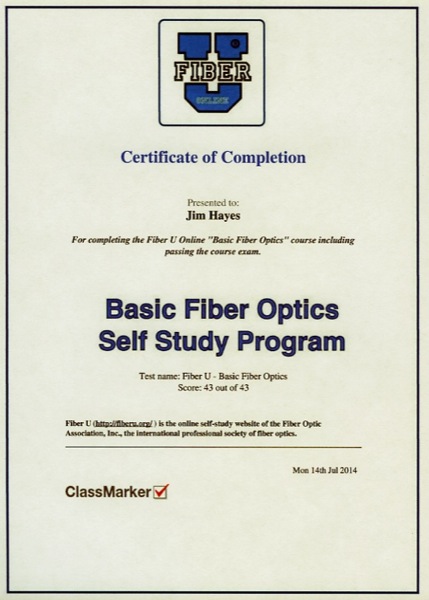
While it's not FOA certification, FOA will recognize a Fiber
U Certificate of Completion as background experience to
qualify for applying for FOA certifications. We also intend to
expand the program to more specialized topics as preparation
for FOA specialist certifications.
If you have associates that want to get started in fiber,
have them take this course online to get started. Go to Fiber
U and get started.
FOA
Books And Publications
Updated
Books


Many textbooks are behind the technology because they are
rarely updated. FOA really keeps our textbooks up to date. We
did a major update a year ago and another was just completed.
The The FOA
Reference Guide To Fiber Optics has been updated
to reflect new components like OM5 fiber, testing for fiber
characterization and more information on installation.
The FOA
Reference Guide To Outside Plant FIber Optics
has been expanded to include an extensive section on outside
plant construction taken from Joe Botha's
OSP Construction Guide textbook. This additional
material is being added to support the new FOA CFOS/O OSP
tech certification program which now includes of OSP
construction.
FOA
Basic Fiber Optic Textbook Available in French and Spanish

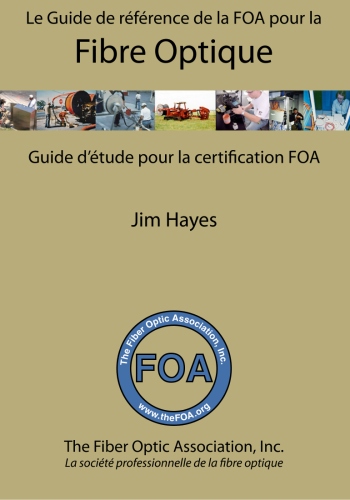
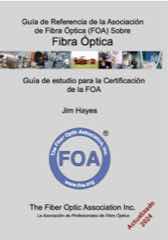


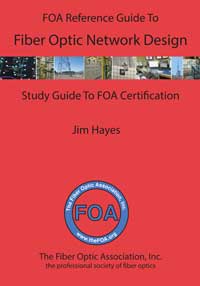
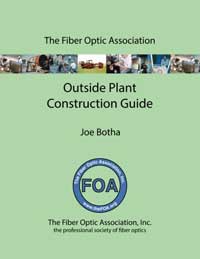
Libro
de Diseño para Redes de Fibra Óptica en
Español - FOA
Design Book Available In Spanish Online
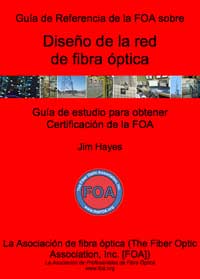
FOA has translated the FOA Guide To Fiber
Optic Network Design book and made it available online to
those studying for the CFOS/D Certification but whose native
language is Spanish. You
can access the Spanish translation of the Design book here.
A printed version will be available in the near future.
Lennie
& Uncle Ted Guides - Perfect For Getting Started
Lennie
and Uncle
Ted's Guides have moved to the FOA website.
Lennie is the place where many if not most fiber techs
begin their education. FOA has just updated the two
guides to ensure they stay relevant - more than 20 years
after they were first written.
Lennie goes all the way back to 1993 when he was created
as the mascot of the original "Fiber U" conference - the
same Fiber U that is now the FOA's web-based training
site. Lennie
Lightwave's Guide To Fiber Optics was created
as a beginner's introduction to fiber optics. Over
60,000 printed version of Lennie's Guide were given away
and it became one of the first commercial web pages in
1994. Uncle Ted's
Guide To Communications Cabling was written a
few years later to introduce techs to "Cat 5" - UTP
wiring - that had only recently been standardized in
TIA-568.
Lennie and Ted's Guides are used in the current Fiber U
online self-study programs and are still the best place
to start learning about fiber optics.
Lennie
and Uncle
Ted's Guides are online at the links here, can be
downloaded as printable PDFs and are now also available
as free iBooks on iTunes.
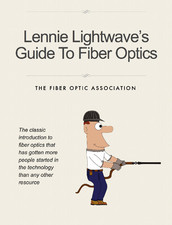

Lennie
Lightwave's Guide to Fiber Optics and
Uncle
Ted's Guide To Communications Cabling
are now available free to iPad users who can download them from
the Apple iTunes store. Of course they are still available
online or for download.
You can also find these free guides on the FOA website - go here
for all the links: Lennie
Lightwave's Guide to Fiber Optics and Uncle
Ted's Guide To Communications Cabling
Download PDFs of Lennie
or Uncle Ted.
RETURN
TO INDEX
FOA
iPad Apps
FOA
LossCalc
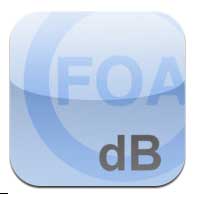 FOA
LossCalc estimates the optical loss of a fiber optic link. This
will save time for the installer of a fiber optic link needing
to know whether test results are reasonable and/or make a
"pass/fail" determination. It can also help the designer of a
link to determine if communications equipment will operate over
this link. FOA
LossCalc estimates the optical loss of a fiber optic link. This
will save time for the installer of a fiber optic link needing
to know whether test results are reasonable and/or make a
"pass/fail" determination. It can also help the designer of a
link to determine if communications equipment will operate over
this link.
By choosing the type of link (singlemode or multimode) and
specifying the length of the fiber and numbers of connections
and splices, it will calculate the end to end loss of the link.
The app has default specifications for singlemode and multimode
links or the user may create custom setups with specifications
appropriate for any application. http://itunes.apple.com/us/app/foa-losscalc/id476262894?mt=8&ls=1
Self -Study in Fiber Optics
 Our
first app is a self-study version of the FOA Reference Guide to
Fiber Optics. The FOA APP builds on the FOA basic fiber optic
textbook to create an interactive learning environment that
builds on the iBook electronic version of the book to add a
guide to use for self-study and real-time testing that provides
feedback on what you have learned and correct answers to
questions answered incorrectly. Our
first app is a self-study version of the FOA Reference Guide to
Fiber Optics. The FOA APP builds on the FOA basic fiber optic
textbook to create an interactive learning environment that
builds on the iBook electronic version of the book to add a
guide to use for self-study and real-time testing that provides
feedback on what you have learned and correct answers to
questions answered incorrectly.
The FOA APP is priced at only $9.99, same as the iBook, so the
self-study program is free. Download it from the Apple APP Store
with your iPad or iTunes.
http://itunes.apple.com/us/app/foa-guide/id434354283?mt=8&ign-mpt=uo%3D4
RETURN
TO INDEX

The
FOA has many videos on  ,
including two Lecture Series (Fiber Optics and Premises
Cabling), Hands-On lectures on both and some other informational
and instructional videos. For all the videos, go
to the FOA Channel "thefoainc" or use the direct links
below. ,
including two Lecture Series (Fiber Optics and Premises
Cabling), Hands-On lectures on both and some other informational
and instructional videos. For all the videos, go
to the FOA Channel "thefoainc" or use the direct links
below.
View
a complete list of FOA Videos with links to each video on
YouTube.
Where Are
The Jobs In Fiber Optics? FOA talks about all the
applications for fiber optics, what jobs involve and the
qualifications for the workers in the field.
Fiber
Optics - Live! A
series of videos that use lab demonstrations to show how
optical fiber works.
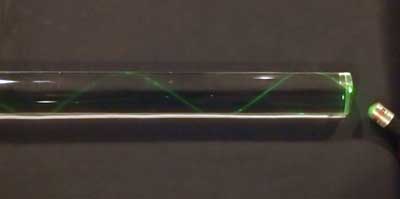
Cabling
Project Management - what's involved in a
copper/fiber/wireless project -advice for the customer and the
contractor
Hazards
Of Counterfeit Cable
You may
have read the stories we have written about the counterfeit
"Cat 5" cable made from copper-clad aluminum rather than pure
copper. Recently we tried an unscientific burn test on the
cable compared to a known good UL tested cable and posted a
video on YouTube. You can see the results below.
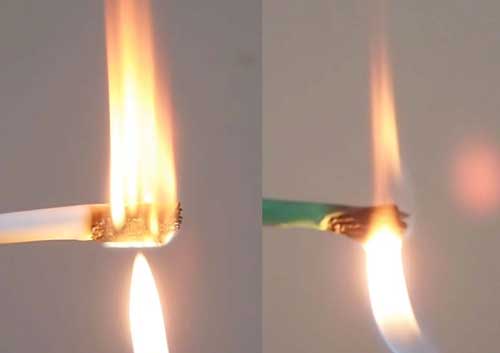
Counterfeit
Cable Real UL-rated cable
The
difference is obvious and the danger is real. Watch the video
on YouTube: Premises
Cabling Lecture 11: Counterfeit Cat 5 Cabling
View a
complete list of FOA Videos with links to each video on
YouTube.
View
all the FOA Channel on YouTube.
RETURN
TO INDEX

What's
New in the FOA Online Fiber Optic Reference Guide?
We are
continually updating the Online Reference Guide to keep up with
changes in the industry and adding lots of new pages of
technical information. Go to the FOA
Guide Table of Contents to see the latest updates - look
for  . .
Search the
FOA Newsletter, Online Guide and website with DuckDuckGo.
Go
to The
FOA Online Fiber Optic Reference Guide.
RETURN
TO INDEX
FOA
Schools
New
School:
Midwest
Communications Technologies, FOA
Approved School #378.
Find
a listing of all the FOA-Approved schools here.
Find An FOA-Approved Training
Organization
Most
inquiries we get regarding finding a FOA-Approved training
organization want to know two things: what school is closest to
me or what school offers the certifications I need. The FOA has
about 200 training organizations we have approved worldwide so
finding the right one can be difficult! We've been looking at
ways to make it easier, and we think we've got a good solution.
In fact we have two solutions.
First we have added a sortable
table of all the FOA-Approved schools.
You can also use our FOA
Google Map to find FOA-Approved schools.
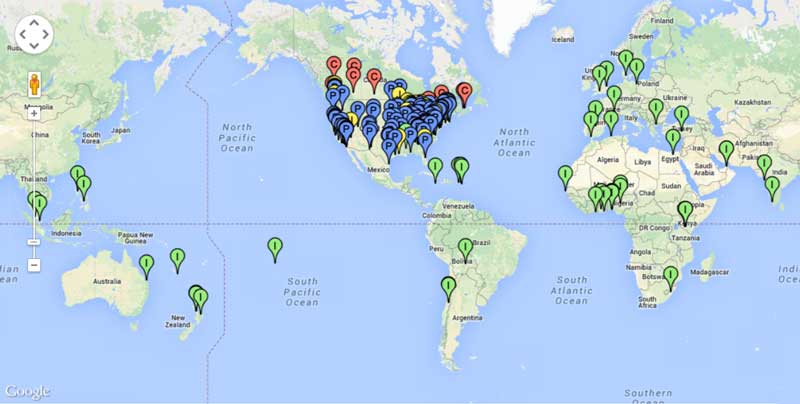
What
Should A Fiber Optics or Cabling Tech Know and What Skills Do
They Need?
FOA
certifications are based on our KSAs - the Knowledge, Skills and
Abilities that techs need to succeed. Read the FOA KSAs
for fiber and cabling techs.
School News
Feedback
We always
enjoy feedback, especially when it shows how great some FOA
instructors are. These came from students of Tom Rauch, an
instructor at BDI
Datalynk:
"I took your fiber optics certification courses this past March.
I just wanted to let you know that in two weeks I start working
as a fiber optic technician with ___ up in ___. You mentioned on
the first day of the course that there is always one guy in
class who had rubbed his last two nickels together to be there
and, in that instance, I was that guy. Now I'm going to be able
to provide for my family like never before and I owe it to the
certification that I received from you and BDI Datalynk. I just
wanted to thank you again."
"Thanks to our tremendously knowledgeable and patient instructor
Thomas Rauch, who was not only generous in sharing his wealth of
information, but he did so with ease, humor and in a way that
invited curiosity and participation. He was encouraging and
proud of our accomplishments and helped us learn from our
mistakes in a way that did not break our confidence, rather it
pushed us to better results the next go around. The hands on
labs were just AWESOME!" Just thought you should know what a
class act you have representing you in his travels..... but then
again you probably already knew that! : )
In almost 19 years at Verizon and having held numerous
positions, I have gone through many training sessions. I cannot
remember ever having been actually looking forward to coming
back to class quickly after lunch, to get back to the hands on
activities, and walking away with the sense of empowerment that
the information presented was not only relevant but dead on
point accurate! I will be signing up for the Outside Plant class
on March! I can't say enough good things about Tom and his
impact! Feel free to quote me, I can only imagine that he will
open so many doors and change so many lives in the years to
come, with his style of teaching! Great experience, awesome job!"
IBEW
and FOA Partner on Fiber Optic Training
The
International Brotherhood of Electrical Workers (IBEW) and the
National Electrical Contractors Association(NECA) through the
National Joint Apprenticeship and Training Committee
(NJATC) in
a partnership with the FOA has published a new textbook for
training IBEW apprentices and journeymen in fiber optics. The
new textbook uses the material from the FOA Reference Guide To
Fiber Optics with new material and photos from other NJATC
training partners.
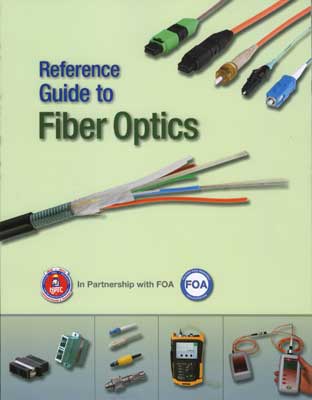
Quote
from one of our certified instructors: I want to thank
you and your organization for all the resources you provide for
the students and the opportunity to offer the certification to
the students. The fact that you published the book yourself to
get the cost down and the unlimited free resources on your
website shows a commitment to the public that is second to none.
I let it be known to the students that the FOA is the best in
the industry at supplying knowledge and resources related to the
communication industry. I look forward to passing on the
information that you provide for the industry.
RETURN
TO INDEX
Good
Question! Tech Questions/Comments Worth Repeating
New:
The FOA Fiber FAQs
Page (FAQ s = frequently asked questions) gathers up
questions readers have asked us and adds tech topics of
general interest.
Real
Questions From FOA Newsletter Readers
OTDR
Resolution
Q: If testing a 40KM link with 1KM launch and
receive cords should I be able to see the connector and cassette
splice on each side? My OTDR setup is at 64KM, 300ns pulse and
10 second test at 1310/1550/1625. It shows as a single event so
far but with the pulse width at 300ns won’t that combine the
events into one event during analysis?
A: You will not be able to resolve a connector and splice
close together, especially on a long link like that. 300ns is
almost 60m pulse width! You will see an even of the splice and
connector combined.
Transmission
Wavelength Compatibility
Q: We are looking at the specs for two devices, A
and B. The spec sheet of Device A lists it is capable of MM in
850nm wavelength. The spec sheet of Device B lists it can do MM
at 1300nm. If I connect these devices via MM patch cord, what is
the impact due to different wavelengths? Will the transmission
suffer significant loss or since both are multimode, wavelength
is irrelevant?
A: Fiber works at either wavelength, but transceivers do
not. The attenuation rate for MM fiber is ~3dB/km at 850nm but
only ~1dB/km at 1300nm. But 850nm receivers use silicon
photodiodes while 1300 nm receivers use InGaAs. The 1300
detectors are not sensitive at 850nm and vice versa. So while
the fiber works fine, the electronics do not. They should only
be used with like devices.
Communications Cables on Utiity Poles
Q: Is there a standard that service providers such as ISP,
FTTH or cable TV should follow when installing their cables on
existing electric poles. For necessary clearances etc. ?
A: The location of comms cables is in the
“Communications Space.” At the top of the pole is the “Supply
Space” for power conductors and between the two is a “Safety
Zone Space.” It is There are guidelines of various types, mostly
referring to NESC Rule 235. One of the best documents on this is
from Nashville
Electrical Service. This presentation
from Finley Engineering offers a good summary.
"Snowshoes"
On Aerial Cable
Q: For
overhead installation, can snow shoes, or other service loop
devices, hold two separate cables?
A: Snowshoes are sized for different
cable sizes and types. Some snowshoes are big enough for several
cables, that’s no problems.
Fiber and Power Sharing Conduit
Q: We are working on a project that has miles of
underground 7 cell innerduct conduit with existing fiber already
running through one of the cells. Is it possible to run
electrical conductors through the 2 of the other cells? The
conductors would be no larger than 1/0 AWG at 480V or 600V. Both
the fiber and the electrical are being installed for the same
use.
A:We questioned several people in the electrical side
that also do fiber work. The opinion is that the electrical may
use the other ducts. If the fiber cable has conductive members,
e.g. armor, it must be properly grounded. And any cables spliced
in manholes need separation and marking. The concern is over
what happens with a dig up, but as long as the electrical is
turned off before restoration begins, there should be no
problem. If you need a reference, The National Electrical Safety
Code (NESC) or ANSI Standard C2 is a United States standard of
the safe installation, operation, and maintenance of electric
power and communication utility systems including power
substations, power and communication overhead lines, and power
and communication underground lines.
Fan-Out
Kits Needed?
Q:I’m
working on some MM fiber and am unsure if I need a fan out
kit. Is there a way I can tell if I do?
A:
Is it 250 micron or 900 micron buffer? Splicing or
termination? Loose tube or tight buffer cable? Generally
loose tube cable with 250 micron fiber needs no fan out
kit for splicing - tubes go to splice tray and bare fibers
are protected in the tray - but probably needs it to
terminate if the fibers are exposed, for eample with SOCs
- splice on connectors. Tight buffer - 900 micron fiber -
does not need fan out kits.
APC
COnnectors
Q:
We've got a discussion going in our department about
whether an APC connection is required at both ends of an
electronics link or just in one spot when trying to
control reflection for broadcast equipment.
Thoughts/advice?
A: It seems you could use APCs on the transmit end
to prevent reflectance bothering the laser source, but it
would get reflectance from the receiver end, probably not
an issue unless you are on short links, like in a data
center where the far end reflectance would not be
attenuated substantially. If you put the APC at the
receiver end, you would still have problems with
reflectance at the transmitter end. Perhaps the biggest
problem is managing to keep patchcords straight. We’d vote
for the simple solution, all APCs, which is what many
people are doing today. Alternatively, use the best UPC
connectors which have only about 10dB worse performance as
long as they are kept clean.
Test Multimode At 1310nm
Q: Can I test multimode over 1310 wavelength?
A: Certainly you can, but why? In fact, multimode fiber
has been tested at both 850 nm and 1300 nm for most of its
history. Some standards still call for testing at both
wavelengths.
When network speeds were 100Mb/s or less, sources were LEDs at
850nm used for shorter links - a few hundred meters - and LEDs
at 1300nm were used for longer wavelengths, up to 2km for
networks like Ethernet, FDDI and ESCON.
When Ethernet jumped to 1 gigabit/s, LEDs could not be used;
they were limited to ~200 Mb/s. The new fast VCSEL sources
(vertical cavity surface-emitting lasers) were adopted for most
links. Some networks still offered a 1300 nm option using 1310
nm Fabry-Perot lasers since VCSELs are limited to about 950nm
wavelength max. The 1310 lasers available were generally
pigtailed with singlemode fiber and required some special launch
cables to prevent modal problems, and even though they offered
longer range, they were not really cheaper than using singlemode
fiber and never gained much popularity. (See Specifications for
fiber optic links and systems, including FTTx)
So multimode fiber became almost exclusively used at 850nm. In
standards committees we discussed dropping the requirement for
testing at 1300nm, but some argued that since the fiber is more
sensitive to stress/bending losses at 1300nm, testing at 1300nm
provided information on the stress in the fiber. Once multimode
fiber became almost exclusively bend-insensitive fiber, that
argument lost validity.
While some standards still call for 1300nm testing and many test
sets offer 850nm and 1300nm LED sources, it’s probably not worth
the time.
Fiber Backscatter Coefficient
Q:
I was wondering if you have an idea of how accurate the numbers
from a fiber datasheet are for the stated backscatter
coefficient of the fiber. When looking at these numbers
reported on datasheets, they are nice round numbers like -77dB,
-82dB etc., which tells me that those aren’t actual
measurements. They are more ballpark values. Would
you happen to know roughly what sort of accuracy those would
have for a given length of fiber?
A: We believe is the number is an average from some tests
done whenever the fiber was designed and first manufactured and
is +/- several dB. Remember it’s not a guaranteed spec like
attenuation coefficient which they do measure.
Remember it is dependent on the pulse width. Corning in the
SMF-28 data sheet quotes the numbers you have for a 1ns pulse
width.
(https://www.corning.com/media/worldwide/coc/documents/Fiber/SMF-28%20Ultra.pdf).
You can probably surmise that 1 ns pulse is hardly a square wave
and there will be lots of variations in the integrated power in
a 1ns pulse created by different instruments. And who knows how
you relate that power to a 5, 10, 20 ns or whatever pulse.
This paper by Corning talks about reflectance and backscatter
and has some interesting points:
https://www.corning.com/media/worldwide/coc/documents/Fiber/RC-%20White%20Papers/WP-General/WP1281_11-2015.pdf.
The key is backscatter is inversely proportional to mode field
diameter, so small changes in fiber diameter can cause changes
in backscatter - and MFD variations of several percent are
possible.
Snowshoes
Q: For overhead installation, can snow shoes, or other
service loop devices, hold two separate cables? I imagine
the bend radius is a factor.
A: Snowshoes come in many sizes and are often sized for
holding several cables, for example loops around dome splice
closures with 2 cables being spliced.
Mismatched
Fiber Losses
Q: If I
have 50 micron test leads for my OLTS and I used them to test a
62.5 micron fiber link what can I expect in terms of
results? Will the 50 micron leads give me (generally)
higher or lower loss values?
A: Yes, you will see higher and or lower loss depending on which
way you test. See this
page in the FOA Guide on Mismatched Fibers.
Pull ADSS Cable In Ducts Underground?
Q: Our city is installing a 1.5 mile run, mostly aerial
and we want to use ADSS cable. There are two or three road
crossings where we want to go underground in conduit installed
by directional boring. Can the ADSS cable be dead-ended, brought
to the ground, figure-8ed and pulled through conduit then
continue the aerial installation?
A: The answer is yes this is not an issue and is done all
the time. It is standard procedure. (Thanks to Pat Dobbins, FOA,
the expert on ADSS cables.)
Microtrenching
Q: I recently read an article you wrote in April of last
year about micro trenching..Currently, I am employed with an
underground construction company. Something we have never been
involved with is micro trenching and would like to possibly get
some equipment and training scheduled in the near future. In
saying that, it has seemed to be almost impossible to find
numbers on the price per foot. Essentially, I am asking if you
have any resources to some up with those numbers or models to
maybe use for pricing purposes.
A: Microtrenching is becoming another tool that
contractors are adopting because like directional boring is is
less disruptive than regular underground construction. I’m
working with one group that’s using microtrenching in CA cities,
installing microducts and a 288 fiber about the size
of a #2 pencil. Cost is difficult to generalize other than “more
than aerial and less than trenching.” Cost is very dependent
on where you are working and what the local geography
looks like. We know one contractor who claimed to do 5 miles a
day in rural Washington at costs near that of aerial. It’s
especially good in areas with lots of base stone where trenching
or boring is near impossible or cluttered utilities downtown.
Here are a couple of pages on the FOA website about
microtrenching:
Outside
Plant Fiber Optic Cable Plant Construction
Underground
Cable Construction
Microtrenching
Ditch Witch sells equipment for trenching and trains users.
Condux has the equipment for blown cable and offers training
several times a year.
Old Multimode Fiber
Q: We have old multimode fiber and we are still connecting
more equipment to it over greater distances and need some way to
insure the equipment will work.
A: I do not know of any simple formula for figuring this
out. Last time I remember such a formula from around 2000 done
for Gigabit Ethernet with VCSELs and the equation reminded me of
the quantum mechanics course I took in physics. The problem is
you have two bandwidth factors, modal dispersion and chromatic
dispersion. Modal dispersion is highly dependent on mode fill,
e.g. the metric “encircled flux” was developed to define the
mode fill of multimode fiber with VCSEL sources for simulations
to estimate bandwidth. Chromatic dispersion is dependent on the
fiber spec and the spectral width of the source which is better
with lasers and LEDs.
What generally happens is the standards group developing the
network standard, especially IEEE 802.3 for Ethernet, runs the
numbers and specifies a maximum distance for the particular
network and its speed. FOA has a table of these specs here: Specifications
for fiber optic links and systems, including FTTx
Can A Fiber Optic Cable
Catch "Fire"
Q: While working on a cut-over of a dwdm circuit
something has happened that I am now looking for an explanation.
A transmission fiber emitted "fire" on that same fiber! We did
not see any optical light we saw fire. About 5 cm of fiber
burned and remained smoke. What phenomenon occurred? Are the
dwdm amplifiers so powerful enough to generate fire?
Unfortunately I could not get into the station to take the model
of the equipment.
A: We’ve heard of high power WDM systems exploding dirt
of the endface of fiber connectors and damaging them, but this
is a new one. We contacted several technical people in fiber
companies and found that this can happen if there was a crack in
the fiber in the cable near the connector or lots of reflection
perhaps caused by a very dirty connector that allowed the very
high power to heat the cable enough for combustion. DWDM with
many multiplexed signals and a fiber amplifier creates a lot of
power confined to a very small core of the singlemode fiber.
That power can ignite the acrylate coating on the fiber.
Installing
ADSS Cable Underground
Q: I'm installing an aerial run of ADSS cable and wonder
if I can pull the cable under roads in duct installed by
directional boring without splicing when I need to go
underground.
A: Yes you can pull ADSS cable in ducts installed by
directional boring without splicing. Just install the ADSS cable
link to the pole where you need to go underground and "dead end"
it at that pole. Drop the cable down, "figure-8" the cable to
prepare for the pull, then pull the cable in the duct. If you go
aerial on the other side, just continue the ADSS installation
procedures.
Reflective Events Causing Transmission Problems
Q: I have a technical question about reflective events. I
recently assisted to troubleshoot an intermittent SM fiber link
for a customer. The cable was dug up a few years ago and a fiber
contractor has (fusion spiced) a different chunk of cable into
the link to repair it. When troubleshooting the link, I checked
the cable with the otdr. I found that each of the 12 fibers had
a reflective event at the fusion splice. This was only at the
splice tube closest to me. The other fusion splices in the other
tube were virtually invisible (as they should be). I'm a little
puzzled as to why there are reflections at the fusion splices. I
did a little research, but couldn't come up with a good answer
as to what is a possible cause of the reflections. (The OTDR
also showed a lot of ghosting on every fiber tested) (in some
cases it recorded over 40 ghost events) Although I haven't been
able to confirm that there is high Bit error rate due to the
transceiver not providing these statistics, (except for 3 out of
10 pings fail) I am suspecting that High reflectance is possibly
the cause of their unreliable fiber link.
A: Reflectance is a big problem in SM links, especially
short links. If you are seeing lots of ghosts, I suspect the
link is very short. Fusion splices can have reflectance if the
splicer is improperly set and the fusion is incomplete or has
bubbles. Those splices should have not only have reflectance but
higher loss. The solution is to open up the closure, use a VFL
to find the reflective events and redo the splices.
Blasting Near Fiber Optic Cables
Q: We
have a project where blasting is planned near fiber optic
cables. We find no standards for this. Is it safe for the fiber
or should we treat it like other utilities like gas and water?
A:
FOA
recommends considering fiber optic cables to be similar to gas
lines when blasting nearby. We know of no standards for this
but there are some descriptions of projects requiring blasting
near fiber optic cable installations. Here is a pipeline
company's guidelines for blasting. The guidelines seems
to focus on staying 5m from the fiber optic cable and using
careful blasting techniques.
Cleaning
Connector Protective Caps
Q:How do you clean LC Fiber Optic end caps (the cap that
covers the cleaned fiber cable)? Is there a tool for that?
A: We assume you are talking about the small plastic
protective caps on the connector ferrule. There is a joke in the
industry that goes “there’s a reason they call them "dust caps’”
they’re often full of dust.” The problem is these are plastic
molded parts that are made by the billions for various purposes
- some just fit fiber optic connectors. They come out of the
molding machine and are dumped in barrels. No provision is made
to keep them clean, plus they will have some mold release
chemicals inside them that can attract or hold dust. Even static
electricity is a problem.
We know no way to clean them nor to keep them clean. We
recommend using them to protect the connector ferrule - in fact
we’re trying to get people to call them “protective caps” - but
after they are removed and before use (connecting to another
cable or a transceiver or testing them) they need inspection and
cleaning.
See these pages in the FOA Guide: Microscope
Inspection And Cleaning of Fiber Optic Connectors Cleaning
Fiber Optic Connections
Directional Splice Loss
Q:
I have a customer that is splicing a fiber distribution hub to
their fiber plant. The fiber distribution hub utilizes
100FT long fiber stubs of SMF G.657.A1 and the fiber plant uses
SMF G.654.D. The project has a contract fusion splice
passing spec of 0.2dB loss, averaged bi-directional and also a
one-way <0.3dB loss (either direction) specification; using
an OTDR for measurements.
From my research, if the splices OTDR’s test results for the 2
directions are -0.2dB / +0.6 (average of +0.2), the network is
not actually seeing a +0.6dB loss; but this is how the OTDR
interprets the backscatter information… the OTDR being somewhat
confused due to the bend insensitive fiber characteristics.
A: Correct - the directional differences are due to the
mode field diameter variations in the two fibers. G.654 is
a large MFD fiber, ~12.5microns, compared to ~9 microns for
G.657.A fiber. The OTDR measures based on backscatter which will
be very different for the two fibers.
Markers For Underground Fiber Optic Cables
Q: I have a general question about above ground
markers for fiber optic cable in conduit. Is there a
recommended spacing for the markers? Is there a standard
to reference for this?
A: We asked some people who make them and they said the
guideline is “line of sight.” The rules for markers are
mainly what information needs to be on them. Of course we also
recommend adding marker tape about a foot above the conduit. I
was curious if there were any legal issues and I found this
interesting page from Cornell Law School: https://www.law.cornell.edu/cfr/text/49/192.707
So I might add to line of sight any crossings of roadways,
rail ways and some markers for bridge crossings.
We have a new section on the FOA Guide: Outside
Plant Fiber Optic Cable Plant Construction that may be
useful.
Reflectance
And Return Loss
Q: Help me understand measuring reflection little better.
Why do we consider -55dB to be a better reading than, say,
-25dB? If reflection and return loss are inverse readings and we
had a 55dB return loss, would that positive reading for return
loss be considered good?
A: Reflectance is measured as the ratio of reflected to
incoming signal at a connection. The confusion comes because
reflectance and return loss are inverse readings. Consider this:
If we have 1/1000 of the light reflected, the reflectance would
be -30 dB (1/1000 = -30 dB) but the return loss would be 30dB
since it is defined as 1000/1, the inverse, and is described as
+30 dB.
Likewise, an APC connector would have a reflectance of -50 dB or
a return loss of 50 dB.
However, return loss as tested by all OTDRs is not be the
reflection from a single event but the total of all reflectance
events plus total backscatter from the length of fiber being
tested in the trace.
This is where most people are confused and misuse the terms.
Older
questions are now available here on the FOA Guide.
RETURN
TO INDEX
Worth
Reading or Watching:
Sign
up at the FOA Pinterest
board 
FOA
"Quickstart Guides"
In our
continuing quest to help people understand how to test fiber
optic cable plants and communications systems, we've created two
more "QuickStart Guides to Fiber Optic Testing." They are
simple, step-by-step guides on how to test fiber optic cable
plants, patchcords or single cables using insertion loss or OTDR
techniques and optical power from transceivers. It's as
straightforward as it can get - what equipment do you need, what
are the procedures for testing, options in implementing the
test, measurement errors and documenting the results.
It can't get much simpler.
Send anybody you know who needs to know about fiber optic
testing here to learn how it's done in a few minutes.
Testing
Fiber Optic Cable Plants And Patchcords
Testing
Fiber Optic Cable Plants With An OTDR
Measuring
Optical Power In Communications Systems
Like
Crossword Puzzles? Here's Some On Fiber Optics

Do you like
crossword puzzles? How about one on fiber optics - or maybe a
half-dozen of them? FOA Master Instructor Eric Pearson of Pearson
Technologies has created a series of crossword puzzles on
fiber optics that are keyed to the FOA CFOT reference materials
and his book Professional
Fiber Optic Installation, v.9. You can have fun and
study fiber optics at the same time!
This months crossword puzzle is on "Optoelectronics and
Splicing" - Download
the crossword puzzle on "Optoelectronics
and Splicing."
If you
missed the earlier puzzles, here they are:
Download
the PDF file of the crossword on "Light and Fiber".
Download
the PDF file of the crossword puzzle on "Cables".
Download
the crossword on "Connectors
& Splices."
Older
Fiber, Do You Know How Good It Is?
There's
millions of miles of long distance fiber installed around the
world and most of it likely to see an upgrade of the systems
operating on it, probably in the near future. Twenty years ago,
most of it was probably running at ~1Gb/s, ten years ago it was
probably 2.5 Gb/s, recently it was likely to be 10Gb/s but now
many are being considered for 100Gb/s or beyond. Can the fiber
support such speeds? Can it be "repaired" or "modified" to make
it possible to use it at higher speeds? If you own that fiber,
can you say what it is worth without knowing its future upgrade
capability.
In order to know the potential for upgrades on your cable plant,
you need to test it. This process involves a number of tests and
is called "fiber characterization." Greg Stearns of TTP-US, an
FOA Corporate Member, performs these tests and has written a
short article on why you need to characterize fiber and how its
done. Read about fiber characterization from someone who does it
often and can explain it well.
Download
the paper here (PDF, 80kB).
Where
In The US Do Contractors Need Licenses For Fiber Optics?
We often
get asked where in the US do contractors doing fiber optic
installations need licenses. We found a good website for that
information, the NECA -NEIS website. You might remember
NECA-EIS, as they are the partner with the FOA in the NECA/FOA
301 Fiber Optic Installation Standard. NECA is the National
Electrical Contractors Association and NEIS stands for National
Electrical Installation Standards. They have a very easy to use
map and table that gives you data on every state in the US, so
mark these pages for future reference.
NECA/NEIS
http://www.neca-neis.org
(See “State Regulations”)
http://www.neca-neis.org/state/index.cfm?fa=state_regs
(all electrical licensing)
Low Voltage: http://www.neca-neis.org/state/index.cfm?fa=specialty_licensing
Benchmarking
Fusion Splicing And Selecting Singlemode Fiber
We've been asked many times "How long does it take to splice a
cable?" It's not a simple answer as it varies with the number of
fibers in the cable and the work setup, including whether one or
two techs are working at a job site. FOA Master Instructor Joe
Botha of Triple Play in South Africa did his own analysis based
on decades of experience both splicing cables and teaching
others how to do it properly. This is one of the best analyses
we have seen because Joe includes prep times as well as splicing
times and differentiates between one tech and two techs working
together. He adds some other tips on fusion splicing too. This
should be mandatory reading for every tech and given to every
student! Here
is Joe's splicing analysis.
Joe also has an excellent writeup on how
to choose singlemode fiber that helps understanding
the different types of G.6xx fiber. Read
it here.
And you will want to read Joe's report on splicing
different types of SM fiber, including bend-insensitive
(G.657) fiber. Read
it here.
Free
- Mike Holt's Explanation Of The US National Electrical Code
(NEC) For Communications Cables
Mike Holt
is the acknowledged expert of the US National Electrical Code
(NEC). His books and seminars are highly praised for their
ability to make a very complicated standard (that is in fact
Code - law - in most areas of the US) easily understood. Part of
the appeal is Mike's great drawings that make understanding so
much easier. Mike makes Chapter 8 of his book available free. It
covers communications cables, telephones, LANs, CATV and CCTV,
for premises applications. Even if you live in a region or
country where the NEC is not the law, you may find this
interesting.
Download
Mike's Chapter Here.
Good
Technical Website For Installers
American
Polywater (http://www.polywater.com/)
has one of the best technical website for cable installers. Check
out their website, especially “Videos,” “Engineer’s Corner”
and “Calculators.” http://www.polywater.com/NNNBSL.pdf
Fiber
Optic Safety Poster
We've had numerous requests to reprint our guidelines
on safety when working with fiber optics, so we have
created a "Safety Poster" for you to print and post in your
classroom, worksite, etc. We suggest giving a copy to every
student and installer.
RETURN
TO INDEX
-
FOA
Tech Topics -
A
Fiber Optic Tester In Your Pocket? (See the video on
 )
)
Yes!
The camera in your old cell phone is sensitive to infrared light
- lots more than your eye - and can detect light in an optical
fiber or from a transmitter. Chris Hillyer,CFOT/CFOS/I,
Master Instructor, Northern California Sound & Communication
JATC brought this to our attention.

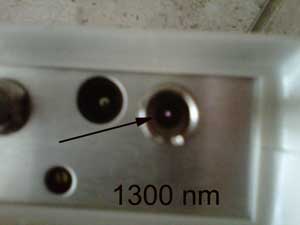
If
you have an old cell phone, try it. Our experience is that older
cell phone cameras have better sensitivity at IR wavelengths
than newer phones, so you may want to toss that old flip phone
into the toolbox.
RETURN
TO INDEX
Product
News
YOKOGAWA OTDR Has Extended range, High Resolution And Multitasking
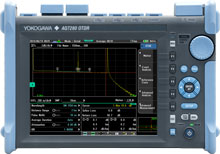
One OTDR manufacturer you don't hear as much about is YOKOGAWA
(formerly ANDO) which is too bad - they make some of the best
OTDRs, exemplified by this new model AQ7280. Need long range -
how about 50dB. High resolution - 0.6m dead zone. Like touch
screens, but for some functions want hard buttons, it's got
that. Options for VFL, microscope, light source and power meter,
etc. - it has that too.
But the unique aspect of the YOKOGAWA AQ7280 is it offers
multitasking - you can let do a trace with long averages while
you inspect connectors, make power readings, use the VFL or
other functions.
More
info on the YOKOGAWA AQ7280.
FOA
thanks Yokogawa for a gift of an OTDR to use for R&D and
teaching!
Have
you read the FOA
pages on cleaning?
- RETURN
TO INDEX
|

























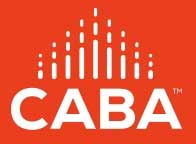





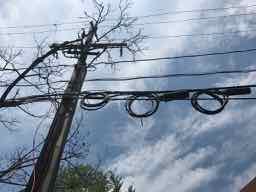

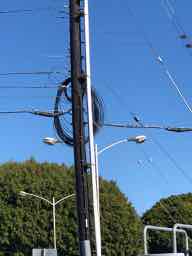
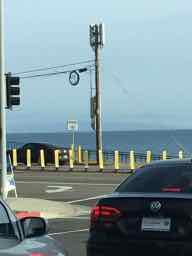

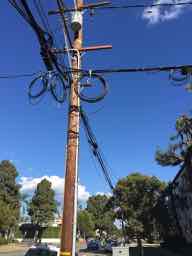
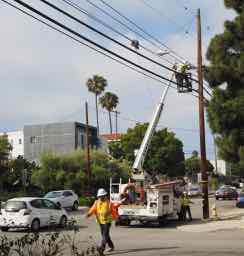






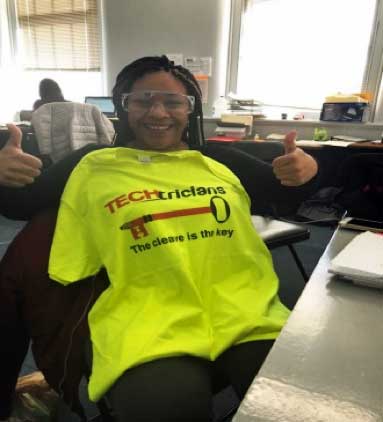































 .
.







